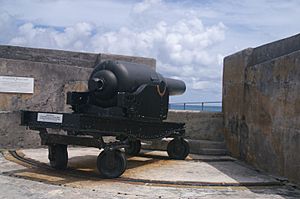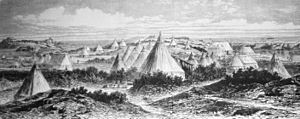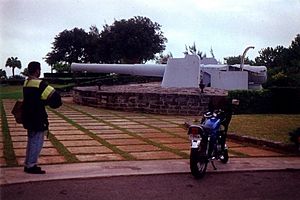St. George's Garrison, Bermuda facts for kids
Quick facts for kids St. George's Garrison |
|
|---|---|
| Bermuda | |
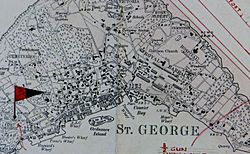
St. George's Garrison (and St. George's Town) as surveyed by Lieutenant Arthur Johnson Savage, RE, in 1897-1899
|
|
|
Location in Bermuda
|
|
| Coordinates | 32°23′02″N 64°40′23″W / 32.383763°N 64.672985°W |
| Type | Barracks |
| Site information | |
| Owner | War Office |
| Operator | |
| Site history | |
| Built | 1793 |
| Built for | Board of Ordnance and War Office |
| In use | 1793 - 1957 |
| Garrison information | |
| Garrison | Bermuda Garrison |
| Occupants | British Army, Royal Navy, Royal Canadian Navy, United States Army Coast Artillery Corps |
St. George's Garrison was the first main military base in Bermuda. It was built by the British in a place called The Somers Isles. Construction started in 1793, during a war between Britain and France. The base was used by the military until 1957. After that, it was given to the local government of Bermuda.
Contents
History of St. George's Garrison
Early Soldiers in Bermuda
The first group of regular soldiers arrived in Bermuda in May 1701. They were part of the English Army. Before this, Bermuda only had part-time local fighters called the militia. These first soldiers lived in private homes in St. George's Town. They did not have their own barracks (military housing).
After a big war called the Seven Years' War ended in 1763, these soldiers left. More regular soldiers came and went over the years. During the American Revolutionary War (1775-1783), some soldiers were stationed in Bermuda. They lived in St. George's Town or in small forts. But after the war ended in 1783, all these soldiers were sent home.
Bermuda Becomes a Key Military Base
After the United States became independent, Bermuda became very important to Britain. It was located about 640 miles off the coast of North Carolina. This made it a perfect spot for a naval base. The Royal Navy (Britain's navy) started planning a large dockyard. This dockyard would be a place to repair and supply warships.
The French Revolution in France made these plans move faster. In 1793, more British soldiers arrived in Bermuda. These included artillery (cannon) experts and infantry (foot soldiers). The Royal Navy also set up a temporary base near St. George's Town. The main naval base would later move to Ireland Island in the west.
Building the Royal Barracks
The regular soldiers and artillery experts were stationed on a hill east of St. George's Town. This area became known as Barrack Hill. Here, the first main military buildings, called the Royal Barracks, were built. Smaller groups of soldiers were also sent to forts around Bermuda. Most of these forts were at the East End, where the main shipping channel was.
The local militia was still important for defence. However, as more regular British soldiers arrived, the local government stopped paying for the militia. After the War of 1812, the regular British military took full control of Bermuda's defence.
Bermuda's Role in the War of 1812
Bermuda's location was key during the War of 1812 (1812-1815) between Britain and the United States. The Royal Navy used Bermuda as its main base. From here, they blocked the Atlantic coast of the United States.
British forces based in Bermuda also launched attacks on the US coast. In 1813, soldiers from Bermuda raided areas near Chesapeake Bay. This was to draw American forces away from Canada.
In August 1814, a large force of 2,500 soldiers arrived in Bermuda. They had just finished fighting in Europe. These soldiers, along with naval forces, attacked the US capital. This led to the Burning of Washington, where parts of the city were burned. They also tried to attack Baltimore. Bermuda was a very important base for controlling the western Atlantic Ocean.
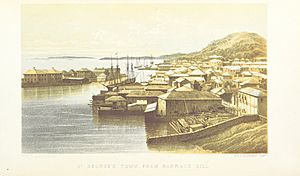
Changes to the Garrison Layout
In 1815, Hamilton became the new capital of Bermuda. The main naval base also moved to the west end of the island. However, the military headquarters stayed at St. George's Garrison. It was the only large army camp in Bermuda at the time.
In the 1840s, a new army camp called Prospect Camp was built near Hamilton. By the 1860s, the main army headquarters moved there. Most of the infantry soldiers also moved to Prospect Camp. But because the biggest coastal defences were still at the East End, the Royal Artillery (cannon experts) mostly stayed at St. George's Garrison.
Later, the Royal Navy gave some of its land in St. George's to the army. This included Convict Bay, which became a Royal Engineers Yard. After 1863, another area called Clarence Barracks in the west was also given to the army. Bermuda was then divided into three military areas. St. George's Garrison controlled the eastern part.
St. George's Garrison included many buildings and forts. These were the Royal Barracks, New Barracks, a hospital, and various living quarters. It also included forts like Fort St. Catherine's, Fort Victoria, and Fort Albert. Other important sites were Ordnance Island (for military supplies) and the Army Service Corps Wharf.
Changes After World War I
Towards the end of the 1800s, fewer forts were needed. This was because new cannons could shoot much farther. After World War I, the British Army made big cutbacks. The regular Royal Artillery and Royal Engineers left Bermuda in 1928.
Local part-time units took over their roles. The Bermuda Militia Artillery was formed in 1895. They were responsible for manning the coastal cannons. The Bermuda Volunteer Engineers were created in 1930. They operated the powerful searchlights used to find targets for the cannons at night. Much of their training happened at St. George's Garrison.
St. George's Garrison in World War II
During World War II, the Royal Canadian Navy used Convict Bay. They called it HMCS Somers Isles. The US Army also used Fort Victoria and Fort St. Catherine's. Both Canadian and US forces left Bermuda after the war ended.
Closure of the Garrison
In 1951, the British government decided to reduce its military presence in Bermuda. They planned to remove all regular British Army units by 1953. This would leave only the part-time local units and the US forces. The US forces had long-term leases for their bases in Bermuda.
However, the decision to close the garrison was quickly changed by Prime Minister Winston Churchill. But another round of military cutbacks led to the garrison's final closure in 1957. All regular British Army personnel left Bermuda. At the same time, most of the remaining military land in Bermuda was given to the local government.
Since the garrison closed, many of its buildings have been used for other purposes. Parts of the New Barracks became police housing and then a school. The old Sergeants' Mess is now a nursery school. The original Royal Barracks no longer exist; new homes were built there. Fort St. Catherine's has been a museum since the 1960s. Some other forts are being restored for visitors. A hotel was built on Retreat Hill, but it was torn down in 2008. The St. George's Golf Course, which was part of the garrison land, is also being redeveloped.
|



